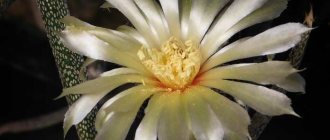Why does a flower stretch upward and not outward?
Sometimes, on the contrary, the cactus quickly stretches upward, rather than in width. This is not very good for the plant. This is most likely the result of overfertilization (especially too much nitrogen). In this case, just try replanting the flower in a different soil, do not forget to add sand to the soil.
Flowers feel our love and care . Prickly on the outside, our green friends are very gentle on the inside. Don't abandon your pets, take care of them, and they will thank you with fast growth and beautiful flowers!
How to care for a mini cactus for beginners
Mini cacti are small-sized plants growing in the same small pots. You can find such cacti in almost every garden store.
These cacti are very easy to care for and even a novice plant lover can grow them on a windowsill.
In addition, such cacti are very compact and will not take up much space. But you can display several different types on your home windowsill at once, creating a unique collection.
And, most importantly, these little “hedgehogs” are very unpretentious and do not require special care.
After purchasing such a “baby” in a store, it is not at all necessary to replant it. It will do well in a small pot.
In winter, when the cactus is at rest, the best place for its wintering is a windowsill. A little winter lighting will be enough for him. The cactus is watered very rarely in winter, only once every four or five weeks.
The main watering is done from the beginning of spring to the end of autumn. Settled warm water is used for irrigation. Watering is done in two ways: into the pan and under the root. At the same time, we must remember that it is better not to add a little cactus than to overfill it.
Mini cacti are not afraid of low temperatures, but the optimal temperature for wintering will be between 5 and 15 degrees.
In addition to watering, cacti must be sprayed with a spray bottle every 2-3 days, also with settled warm water.
In the summer, cacti standing on the windowsill can be opened slightly, giving them access to fresh air. You can also build a special shelf on the balcony.
As the roots of the cactus grow, it is transplanted into a new pot. This is usually done once every two years. For each transplant, the capacity is selected slightly larger than the previous one. Moreover, if the root system of the cactus is taprooted, i.e. is elongated, then the pot needs to be tall. If the roots grow wide, then a wide pot is needed.
There are many types of mini cacti. The most popular among them are: Blossfeldia liliputana, Rebutia minuscula, Lophophora williamsii, Obregonia denegrii and Ott's Notocactus, which is shown in the photo below.
When growing mini cacti, pay attention to their location. A window sill located on the south or west side is best suited
Such cacti grow best at temperatures from +20 to +25 °C. If you plant a cactus in a new pot, then you need to put drainage on its bottom. Expanded clay stones are best suited for this purpose. Can be grown in separate pots or in a common container. But at the same time, it is necessary to plant them at a distance of at least 10 cm so that the roots do not intertwine. You can also divide the cacti among themselves with partitions.
Watering is done as the soil dries. Fertilizing is done along with watering. The best solution is a soluble fertilizer, which can be applied both as a top dressing and as a watering at the same time. The cactus is fed only once a month and only in the spring and summer.
Before you start replanting the cactus, you need to stop watering a week before. After transplanting, you can water only after two days.
If you decide to also propagate your cacti, then this is done in the following ways:
- sowing seeds,
- rooting cuttings,
- planting shoots,
- graft.
Sowing seeds is carried out in the same way as with other plants. The seeds are laid out on the ground and sprinkled with earth. The container is covered with film and placed for germination. Every day the container is opened for ventilation and when the soil is dry, the soil is moistened. After a week, the seeds produce their first shoots.
Leaf-shaped forms of cacti are most often propagated by cuttings. Before rooting, the cutting site is dried and placed in moist soil. Moreover, the cuttings are not buried, but simply placed, slightly pressed into the ground.
The grafting method is a little complicated, and not everyone will be able to use it without the skill of such work. An incision is made on the trunk of the cactus - a small area is removed, in place of which a fresh cutting is attached, which must be fixed.
The most common method of propagation is planting by shoots or children.
When such shoots appear, they are separated from the mother trunk and simply transplanted into another pot.
Caring for cacti is easy, but it is not always possible to get them to bloom.
How to care for a cactus in winter
Around mid-October, cacti already feel the approach of winter, as the light becomes less and less. At this time, they need to create coolness, which is very difficult to do at home. But you have to try to do this: it is in winter that the cacti’s growth from the past summer ripens and flower buds are laid.
Temperature conditions
How long should cacti be kept cool? For most species, 2–3 months is sufficient. True, there are species that can bloom even after a warm winter, but there are not many of them, for example, notocactus, melocactus or aporocactus. But they also need to be given a rest: during the three winter months, water them only a few times with literally a teaspoon of water and not feed them at all, and still try to make them cooler at night.
Most species will not bloom without winter coolness. And if for mammillaria and rebutia it is enough to lower the temperature to 12–15 °C, then for other species - up to 5–8 °C (the temperature must be lowered gradually). In most cases, such conditions can be realized on cold window sills if you place the pots closer to the glass, but to control it, you must place a thermometer nearby. Even short-term warming, lasting a couple of days, can cause cacti to grow and become distorted. On the other hand, in some cases the temperature of the glass may drop even lower, which is also dangerous, since the roots may freeze.
Some gardeners make “greenhouses” for wintering cacti, somewhat reminiscent of an aquarium. Often they place pots not just on the windowsill, but also arrange various barriers so that the heat from the radiator does not reach the cactus. You must constantly monitor the weather outside: if it gets cold, you may need to put foam under the pots or move them closer to the radiator, and vice versa. You should not move pots from place to place unless absolutely necessary. As spring approaches, temperatures gradually begin to rise.
Real flower growers make special wintering apartments for their cacti
Natural lighting on the windowsill in winter is absolutely enough for cacti, but if they begin to wake up ahead of time (for example, already in February it is not possible to keep the temperature low), they will have to organize lighting. In this case, the soil will need to be moistened little by little, otherwise the plants will stretch out.
Soil and air humidity, fertilizing
Watering as such is stopped in winter, but it is necessary to prevent the cacti from shrinking. Of course, the reduction in watering, starting in the fall, should be gradual, simultaneously with a decrease in temperature. If the soil is completely dry in winter, you need to monitor the condition of the plants. To prevent them from drying out, you may need to pour literally a few drops of water per month under the roots or lightly spray the plants and soil with a spray bottle. But just slightly: a few extra drops of water in the cold can already cause plants to rot.
In winter, water cacti with lukewarm water, letting it flow at the edge of the pot. Little by little, the amount of water begins to increase in March. They should not be fed until spring; cacti should not receive any food all winter.
In winter, just 1-2 sprays from a spray bottle onto the soil is enough
As for air humidity, it is known that during the growing season cacti even have to be sprayed sometimes: they do not like dry air. In winter, if they are placed on the windowsill and covered from the radiator, there is no need to worry about humidity.
Transfer
Despite the fact that cacti are sent into hibernation for the winter, it turns out that they can be replanted at the beginning of winter. It is in a state of relative dormancy that most plants are replanted! It is better not to delay this and organize a transplant from mid-November to mid-December. The soil in the new pot should be completely dry.
After knocking on the walls of the pot with the plant, the cactus is removed by the root neck from the pot with a lump of earth. If the cactus is healthy, the old soil can be left on the roots, lightly squeezing the lump with your hands to remove any possible air pockets at the roots. After this, the cactus is planted in the usual way in a new, more spacious pot.
Even when transplanted at any other time of the year, cacti are not watered for the first week. In winter, this rule should be even stricter: transplanted cacti are immediately returned to wintering, and the winter watering regime remains the same, regardless of the procedure performed.
Video: transplanting cacti
Caring for cacti in winter comes down to providing them with peace, coolness and dryness. And if at the very beginning of winter they can and should be replanted, then in the future, until March, it is better not to touch them at all.
How to deal with pests and diseases?
Sometimes the cactus “freezes” and does not grow for a long time. In this case, monitor it for pests and diseases. The most common cause is damage to the root system. Wash the roots, treat them and plant the plant in new soil; you can pre-calcine it in the oven.
The most common diseases:
Late blight . The rotten part can be cut off, sprinkled with ash, and dried.- Dry rot . There is practically no treatment, only prevention is possible - treatment with fungicides.
- Mottled rust . To fight, use the drug Topaz or Bordeaux mixture.
- Stem rot . Appears on young plants; affected plants are usually removed.
- Fusarium . A sign of the disease is a pink or purple coating on the stems of the plant. Diseased plants are destroyed.
What pests can be found:
- Spider mites . Rusty, brown or gray spots appear. To destroy them, acaricides and natural insecticides are used (decoctions of garlic and onions, which are used to wipe the stems).
- Mealybugs . They are visible to the naked eye, egg laying in the form of lumps of cotton wool. Insects are removed with a brush or tweezers. The plant is treated with an alcoholic infusion of garlic. or special insecticides.
- Root scale insects . White coating on the roots. Treating the soil with karbofos helps.
Read more about diseases and pests of cacti here.
It is important to know not only how a cactus grows, but also about reproduction, care, flowering, adaptation to the environment, juice, spines and fruits of cacti.
Where do succulents live?
Name " succulent"
" comes from the Latin "succus" - juice.
Under the name “ succulents
,” plants from different families with succulent leaves and stems are combined.
This similarity is explained by similar living conditions - these plants live
in arid areas, deserts and even in roadside dust.
Interesting materials:
How to use potassium monophosphate correctly? How to use sapropel correctly? How to take potassium chloride correctly? How to take wormwood correctly? How to properly pinch a blue spruce? How to properly pinch tomato seedlings? How to properly sew Velcro onto a lambrequin? How to graft plums correctly? How to properly break in an engine? How to properly prune a peach?
General care tips
Caring for mix cacti is not difficult. Even a novice gardener can grow them. But this does not mean that they do not need to be looked after at all. First of all, you need to choose the right place for the cactus, as this will affect its development and growth. Deciding on a location is not always easy, since the first condition is good lighting.
Another difficulty is the heating season. The fact is that in winter, when the temperature is above normal and the air is very dry, the plants enter a dormant phase, and then suddenly there are hot batteries. Cacti will do well on the windowsill, especially if you place them closer to the glass, but there should be no heating devices under the window sill.
When choosing a pot, pay attention to the fact that its size should correspond to the size of the roots when straightened. Clay and plastic pots are suitable for growing at home
In plastic pots, the soil dries out more slowly, so they are good for young plants that are just starting to take root.
By the way, pay attention to the shape: it should be round, as air circulation occurs better. The soil for planting Dutch cacti must be loose
Water the cactus mix with soft and clean water (rain, boiled or settled water is suitable). Plants need watering from late spring to early September. If a succulent is deprived of water in winter, it may bloom. In order for vegetation to grow normally, light and warmth are needed. At the same time, they are not afraid of frosts and sudden changes in temperature.
To care for a mix of cacti, which contains all known species, you need to create a program that will include features for caring for individual varieties. For example, you need to care for cacti with multi-colored needles in the same way as their traditional counterparts, but you need to water them once every ten days, and you should not spray them so as not to wash off the coloring pigment. Succulents with long needles, on the contrary, need spraying.
Gymnocalycium, for example, prefers diffused light and partial shade. Decembrist can generally grow in the shade, and it rarely needs to be watered, and it also loves “showers”. As we have already noted, if you do not water the plant during the winter months and place it in partial shade, it is guaranteed to bloom. In summer, domestic hedgehogs can be placed outside in the sun. This will speed up growth and make them big and plump. In March-April you should feed the plants, but you should not do this during the flowering period. Rare watering, sun and fertilizing on a schedule is all that cacti need. Feed this plant a month before flowering, during and during the dormant period, otherwise the plant will grow instead of producing a flower bud.











